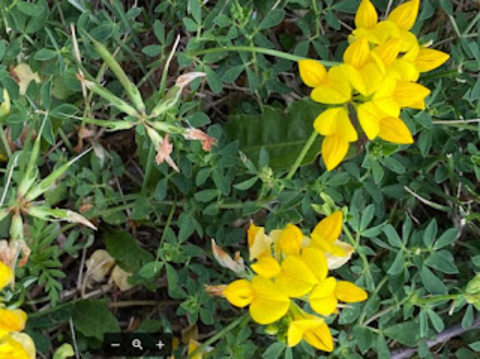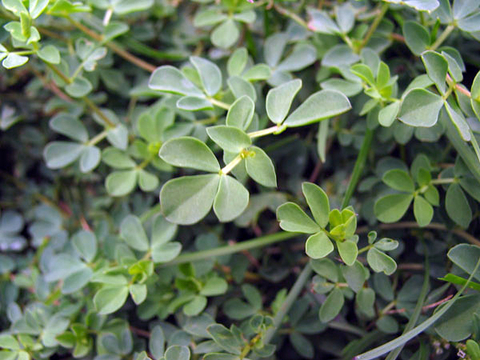Quick facts
- Birdsfoot trefoil is a member of the legume family and can be identified by its low-growing, yellow, pea-shaped flowers and seed pods resembling a bird’s foot.
- Controlling nitrogen levels in the soil, regular mowing, and hand removal are effective for managing small patches.
- Birdsfoot trefoil is invasive in some environments but is also used for forage, nitrogen fixation, and by bees as a source of pollen and nectar.
- Do not intentionally seed birdsfoot trefoil in fields adjacent to native prairie management areas and do not include birdsfoot trefoil in wildlife or deer seed mixes. These actions will limit the chances of birdsfoot trefoil spreading into natural areas.
- Birdsfoot trefoil is a non-native plant that can be invasive in natural areas.
Characteristics
Birdsfoot trefoil (Lotus corniculatus), also known as “eggs and bacon,” is a low-growing perennial member of the Fabaceae (legume) family. Typically growing between 4 inches and 1 foot high in garden and landscape settings, birdsfoot trefoil spreads via seeds, rhizomes and stems.
Flowers, fruit and seeds
- Bloom time: late spring to late summer.
- Birdsfoot trefoil has 1/2 inch yellow, pea-shaped flowers with three petals arranged in a whorl, circling the stem.
- Flowers may become orange or red.
- 1-inch long seed pods form after flowering and contain approximately 10 to 50 small black or brown seeds.
- The seed pods resemble a bird’s foot.
- Some seeds can remain viable in the seed bank for a decade.
Leaves
- Birdsfoot trefoil has oval trifoliate leaves (3 leaflets) at the tip of its leaf stems (petioles) and 2 small leafy stipules (leaflets) at the base of the petiole.
- The name "trefoil" derives from the leaves being trifoliate.
- Alternate growth.
Stem and roots
- Stems typically grow horizontally along the ground, rising to vertical at the tips (decumbent).
- Nodes can root.
- Roots form a vertical, branched taproot as well as horizontally growing rhizomes.
- New plants can grow from rhizomes.
Where it thrives
Birdsfoot trefoil thrives in direct light and nutrient-poor soils of varying moisture levels. It likes turf environments such as roadsides and indicates soils with low nitrogen content.
Control and management
Birdsfoot trefoil is viewed as beneficial or invasive depending on where it is grown. The Minnesota DNR acknowledges that birdsfoot trefoil can be invasive in certain situations due to its ability to choke out other plant species.
Control and management may be required when the plant is grown in an undesired area. Avoid burning to control birdsfoot trefoil, as it can assist in germination.
Turf
- Hand removal is effective for removing small patches but may need to be repeated.
- Remove all parts of the roots and shoots to prevent regrowth.
- A dense and healthy turf is the best defense against birdsfoot trefoil encroachment.
- Maintaining adequate nitrogen levels assists in birdsfoot trefoil prevention.
- Regular mowing at a height of 3 inches or higher helps to manage birdsfoot trefoil.
- Chemical application is most effective in the spring or fall.
- Chemical application of MCPA and Clopyralid may be effective for removal with repeated applications.
- Selective, postemergence combinations for effective control:
- 2,4-D + MCPP + Dicamba
- MCPP + MCPA + Dicamba + Carfentrazone or Triclopyr
Garden
- Hand removal is effective for removing small patches but may need to be repeated.
- Remove all parts of the roots and shoots to prevent regrowth.
- Maintaining adequate nitrogen levels assists in birdsfoot trefoil prevention.
Benefits to the landscape
Birdsfoot trefoil is used for forage, in grazing systems, for nitrogen fixation, and as an erosion control method. The legume is effective as a forage due to its high environmental adaptability, non-bloating traits, and capacity to reseed.
Birdsfoot trefoil is also used as a groundcover to attract bees as a source of nectar and pollen when other plant species are unable to thrive. Bees are the only pollinators that can easily access the plant’s pollen due to the flower's petal structure. Butterflies also use it as a food source.
Conservation, invasive status and native status
- Introduced.
- Invasive in some environments.
- Birdsfoot trefoil is native to parts of Europe and Asia.
- First introduced to the United States as a forage crop and for erosion control.
Plants that look similar
- Black medic
- White clover
- Yellow woodsorrel
- Yellow sweetclover
Reviewed in 2024



